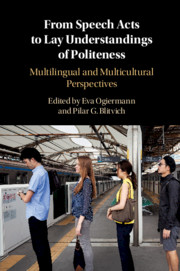Book contents
- From Speech Acts to Lay Understandings of Politeness
- From Speech Acts to Lay Understandings of Politeness
- Copyright page
- Contents
- Figures
- Tables
- Contributors
- Im/politeness between the Analyst and Participant Perspectives: An Overview of the Field
- Part I Concepts and Cultural Norms Underlying Speech Acts
- Part II Concepts and Cultural Norms Underlying Politeness
- Epilogue: Personal Encounters with Politeness Research
- Index
- References
Im/politeness between the Analyst and Participant Perspectives: An Overview of the Field
Published online by Cambridge University Press: 14 June 2019
- From Speech Acts to Lay Understandings of Politeness
- From Speech Acts to Lay Understandings of Politeness
- Copyright page
- Contents
- Figures
- Tables
- Contributors
- Im/politeness between the Analyst and Participant Perspectives: An Overview of the Field
- Part I Concepts and Cultural Norms Underlying Speech Acts
- Part II Concepts and Cultural Norms Underlying Politeness
- Epilogue: Personal Encounters with Politeness Research
- Index
- References
Summary
This volume is dedicated to Maria Sifianou, whose diverse contributions to the study of politeness over the last 30 years have had a significant impact on the development of the field. Her numerous publications have not only helped refine and deepen our understanding of a wide range of politeness phenomena, but have also provided alternative interpretations, enabling us to view politeness through a cultural lens. The volume reflects the remarkable breadth of her scholarship by providing a coherent treatment of politeness as well as a broad multilinguistic perspective, with its 12 chapters examining a wide range of languages and language varieties.
Keywords
- Type
- Chapter
- Information
- From Speech Acts to Lay Understandings of PolitenessMultilingual and Multicultural Perspectives, pp. 1 - 24Publisher: Cambridge University PressPrint publication year: 2019
References
- 24
- Cited by



